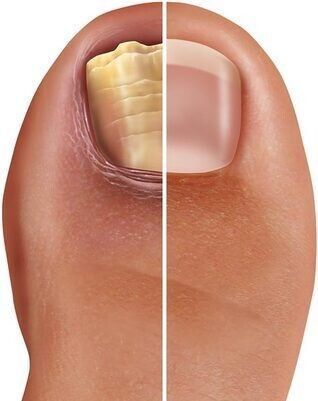What is a fungal nail infection?
Fungal nail infections can occur in fingernails and toenails. Fungal nail infections are an extremely common, yet treatable condition which makes up about 50% of all nail problems.
Early diagnosis and treatment of a fungal nail infection can increase your chances of a successful cure and helps reduce the change of long-term nail damage. Unfortunately, fungal nail infections will not go away without suitable treatment.

What causes a fungal nail infection?
Fungal infections prefer to grow in warm, dark, damp environments making toenails far more susceptible to an infection as your shoes and socks make a perfect environment for fungus to grow.
Dermatophytes (fungal organisms that require keratin to grow) make up around 90% of all fungal nail infections, are most commonly located at the nail's free edge and slowly spread down the side of the nail towards the nail bed.
These dermatophytes can spread to the skin causing a fungal skin infection also known as athletes’ foot. Athletes’ foot can also cause onychomycosis.
Conditions such as athletes' foot, ringworm and jock itch can contain the same type of fungi that cause fungal nail infections. Public areas such as gym changing rooms, communal showers or swimming pools are common areas of exposure due to their moist, warm environments which can create a perfect breeding ground for fungi.
People that wear socks and shoes all day also create a warm, moist and dark environment for fungi to thrive and this suggests why fungal nail infections in the feet are far more common than in the hands. Additionally, we do not tend to wash our feet as much as our hands. Our feet also have less circulating blood than our hands making it harder for our immune system to fight off a fungus infection if we are exposed.

Other Factors that can lead to fungal nail infections include:
Minor skin/nail injuries
Nail deformities
Prolonged exposure to moist conditions/environments
Using tools that have been used on other people (most notably nail clippers)
Wearing closed-in-footwear that is not breatheable
Having diabetes, poor blood circulation
Signs and Symptoms include:
The characteristics of a fungal nail infection depend on the cause, but may include:
Lifting, thickening, or crumbling of the nail plate
Discolouration, usually in streaks
White, yellow or green smelly discharge
Flaking and pitting of the surface of the nail plate.

